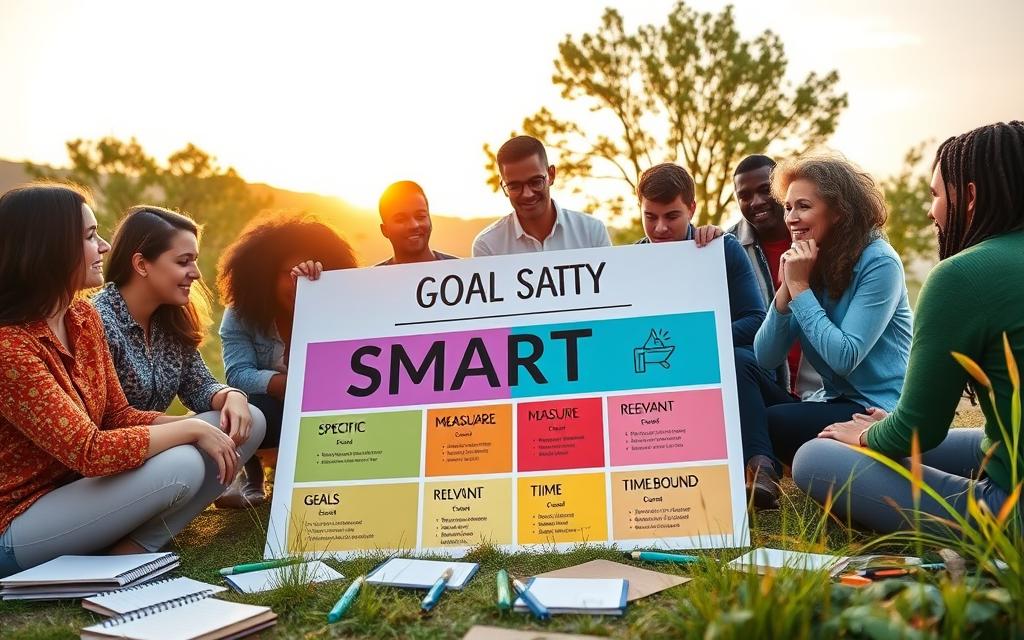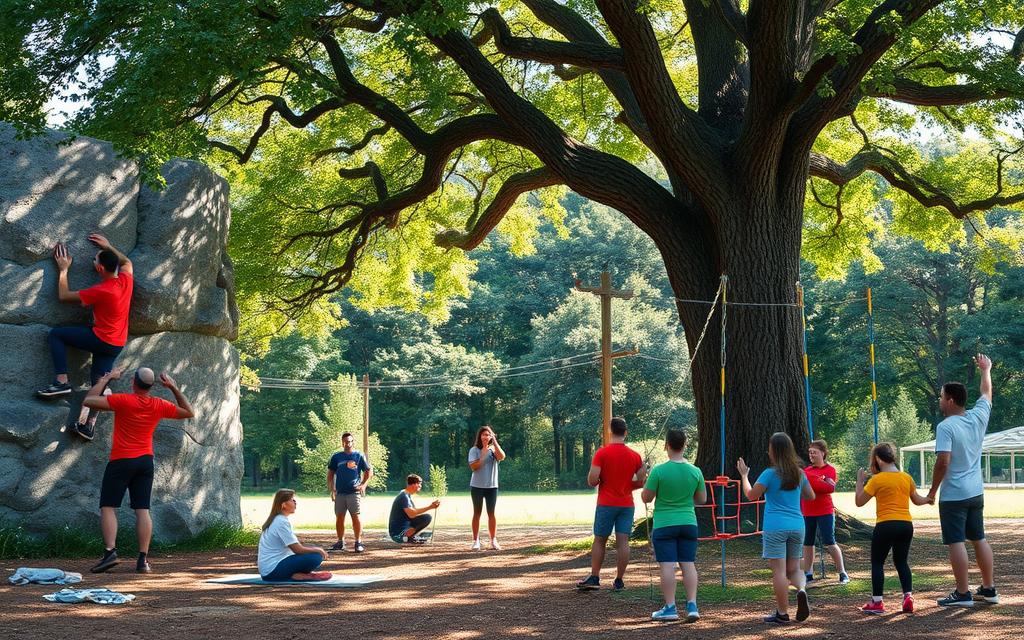Confidence is a journey, not a fixed point. As an athlete, I’ve found that a strong self-confidence mindset is key. It helps us reach our full potential and excel under pressure. By practicing, we can build self-belief, making challenges fun and successes even sweeter.
We’ll look at exercises and strategies to boost confidence. These have helped many people grow personally and professionally. We’ll explore morning rituals, visualization, and more. These methods are backed by science and can change your mindset, helping you achieve your goals.
Self-confidence is a skill we can improve over time. By understanding how to build confidence, we start a journey of self-discovery and success. Let’s dive into the psychology behind it and how it can change our lives.
Understanding Self-Confidence and Its Impact on Success
Self-confidence and self-esteem are closely linked and crucial for personal growth and success. Self-confidence is believing in your abilities. Self-esteem is about feeling good about yourself, no matter what. Both are key to overcoming life’s hurdles and reaching our goals.
Defining Self-Confidence vs. Self-Esteem
Self-confidence means you trust yourself to handle things and reach your goals. It’s about believing in your skills and making smart choices. Self-esteem, on the other hand, is about valuing and accepting yourself, win or lose.
The Psychology Behind Confidence Building
Building confidence is a skill that can be learned. It involves facing your doubts, changing negative thoughts, and doing things that make you feel capable. By working on your thoughts and feelings, you can build a more positive self-image.
Why Confidence Matters in Personal Growth
Confidence is essential for success in many areas, like work, relationships, and health. People with confidence are more likely to take risks and keep going when things get tough. It also helps you stay strong emotionally and keep a positive outlook.
The Foundation of a Confident Mindset
Building a positive thinking mindset is key to self-confidence. It begins with knowing your values, strengths, and areas to work on. By improving your self-image, you can change your inner story and increase your mental strength.
Mental photoshopping is a great technique. It involves seeing yourself as the best version of yourself. This can help you fight negative thoughts and build a stronger self-image. It’s important to get rid of beliefs that hold you back from reaching your goals.
- Reflect on your personal values and how they align with your goals.
- Identify your unique strengths and leverage them to boost your confidence.
- Embrace a growth mindset, seeing challenges as opportunities for learning and improvement.
- Challenge negative self-talk and replace it with affirmations that uplift your self-image.
Having strong self-belief is vital for lasting confidence. By focusing on positive thinking and a healthy self-image, you’ll unlock your full potential and achieve success.
Self Confidence Mindset Exercises for Daily Practice
Building self-confidence is a journey, and daily practice is key. Morning rituals and evening reflections can boost your confidence. Let’s look at some daily exercises to help you grow.
Morning Confidence Rituals
Begin your day with daily confidence exercises to lift your mood. Try power poses like standing tall. This can make you feel more confident.
Also, spend a few minutes on mindfulness meditation. It helps you stay calm and focused.
Evening Reflection Practices
Reflect on your day as it ends. Journaling can help you process your experiences. It’s a way to see your growth.
Try the Triple Column Technique for journaling. It helps you overcome negative thoughts and boosts positive self-talk.
Mindful Self-Talk Techniques
Our inner dialogue affects our confidence. Notice your automatic negative thoughts (ANTs) and change them to positive affirmations. CBT exercises like the Triple Column Technique can help you do this.
Being consistent is crucial for a confident mindset. Add these exercises to your daily routine. You’ll see the positive change it brings.
The path to self-confidence is long but worth it. Be patient and celebrate your small wins. With persistence and a challenge to your beliefs, you can achieve a confident mindset.
Visualization Techniques for Building Inner Strength
Visualization is a strong tool for boosting confidence and inner strength. It helps you see yourself achieving goals and facing challenges. This way, you build faith in your abilities and get ready for success.
Using visualization regularly can deeply affect your life. It helps reduce anxiety and boosts performance in many areas. This method connects your mind and body, changing negative thoughts into positive ones.
- Creative Visualization: Picture yourself in a positive future, using all your senses to make it real.
- Mirror Work: Stand in front of a mirror and tell yourself about your strengths and worth, looking into your eyes.
- Affirmation Visualization: Mix positive affirmations with mental pictures to strengthen your beliefs and goals.
- Guided Visualization: Follow a script or recording that guides you through a visualization, adding relaxation and emotions.
These visualization methods train your mind to think about success and build a positive mindset. The more you practice, the stronger your inner strength and self-belief will become.

Visualization is a powerful practice that can change your life. It helps you beat self-doubt, lowers stress, and unlocks your full potential. Try these techniques and see how they can boost your confidence and inner strength.
Developing Self-Compassion Through Mindfulness
Building real confidence starts with self-compassion. Mindfulness meditation helps us accept our flaws and forgive ourselves. These steps are key to a confident mindset.
Accepting Imperfections
Self-compassion means seeing our flaws without judgment. Self-compassion exercises like the Self-Compassion Break help us do this. This acceptance is the first step to growing and being kind to ourselves.
Practicing Self-Forgiveness
Self-forgiveness is vital when we face setbacks. It lets us move forward with emotional intelligence and strength. This practice strengthens our self-compassion and resilience.
Building Emotional Resilience
Mindfulness and self-compassion boost emotional resilience. They help us manage overwhelming emotions. This resilience lets us face challenges with confidence and understanding.
Mindfulness and related exercises are key to a confident mindset. By accepting ourselves, forgiving, and building resilience, we grow. This growth is the base for lasting success and personal development.
Goal Setting Strategies to Boost Confidence
Setting and achieving goals is a great way to build self-confidence. Using SMART criteria (Specific, Measurable, Achievable, Relevant, Time-bound) helps set clear goals. Breaking big goals into smaller steps keeps you motivated and boosts confidence.
A personal development plan with SMART goals can really help. It lets you track progress and feel good about reaching milestones. This boosts your sense of self-worth and ability.
- Identify specific, measurable goals that align with your values and priorities.
- Ensure your goals are achievable and relevant to your personal growth and development.
- Establish a realistic timeline for reaching your goals, with checkpoints along the way.
- Celebrate small wins and maintain a positive mindset as you work towards your objectives.
- Regularly review and adjust your goals as needed to keep you motivated and on track.
Adding confidence-building activities and positive affirmations can make your goals even more effective. This creates a powerful boost to your self-confidence and personal growth.

Building confidence is an ongoing journey. But by setting SMART goals and celebrating your wins, you can find a new sense of self-belief and empowerment.
Overcoming Self-Doubt and Negative Self-Talk
Self-doubt and negative self-talk can block your path to self-confidence. The first step is to identify any limiting beliefs that hold you back. These beliefs might show up as self-criticism, feeling like an imposter, or doubting your abilities.
Reframing Negative Thoughts
Using cognitive restructuring can change negative thoughts into positive ones. By challenging and replacing negative thoughts with cognitive restructuring, you can start to think more positively. This leads to positive self-talk and more self-confidence.
Creating Positive Affirmations
Creating and using positive affirmations is a strong way to fight limiting beliefs and self-doubt. These affirmations should be positive, clear, and match your goals and self-image. Say them every day to boost your self-belief and fight off negative thoughts.
Remember, beating self-doubt and negative self-talk takes time and effort. With dedication, patience, and the right methods, you can build a confident mindset. This mindset will help you reach your goals and live a happy life.
Building Confidence Through Physical Presence
Our physical presence greatly affects our confidence. Standing tall, keeping good posture, and speaking slowly can make us seem more confident. These actions change how others see us and how we feel about ourselves.
Studies reveal that our body language can change our hormone levels. This means being confident can actually make us feel more confident. Activities like making eye contact, practicing for big moments, and doing physical activities can boost our self-assurance.
Getting used to public speaking can make us less nervous and more confident over time. Learning a new skill also increases self-esteem. It shows us we can reach our goals with hard work and dedication.

By using these body language and non-verbal communication tips every day, we can develop a confident posture. This can lead to lasting improvements in our self-confidence and belief in ourselves.
The Role of Gratitude in Confidence Building
Gratitude is key to building self-confidence. It involves being thankful and appreciative. Keeping a gratitude journal helps you focus on the good in your life. This change can greatly improve how you see yourself.
Daily Gratitude Practices
Adding gratitude to your daily routine boosts confidence. Studies show it reduces depression, anxiety, and stress. It also improves sleep, energy, and health.
By reflecting on what you’re thankful for each day, you build a positive mindset. This mindset is self-appreciative and resilient.
Celebrating Small Wins
It’s important to celebrate your achievements, no matter how small. Research shows gratitude increases happiness and decreases depression. This shows its big impact on emotional health.
By acknowledging your progress and successes, you boost your confidence. This strengthens your positive psychology and self-worth.
Gratitude practices can change your life for the better. They can boost your confidence and well-being. Whether through journaling, meditation, or thanking others, gratitude helps you see your strengths. This leads to a more confident and empowered you.
Developing Resilience Through Challenge Acceptance
Resilience is key to lasting confidence. By facing challenges head-on, people can grow stronger and more self-assured. A growth mindset helps see obstacles as chances to learn and get better.
Studies reveal that resilient runners finish races faster than others. Being resilient also boosts mental health and happiness. Yet, building resilience requires more than just mental skills like positive thinking.
Resilience has three main parts: personal qualities, a supportive environment, and a challenge mindset. A challenge mindset sees stress as a chance to grow, not something to fear. This mindset can make you better at endurance sports and improve your mental state.
To develop a challenge mindset, first, acknowledge and accept negative thoughts. Then, change them into positive ones. Activities like exercise, yoga, and meditation also help build resilience in adults.

Embracing challenges and growing your mindset are vital for resilience. These practices help you overcome hurdles and achieve lasting success. By doing so, you build the strength and confidence to reach your highest potential.
Creating a Support System for Confidence Growth
Building a strong support system is key for self-confidence. Finding mentors and role models can offer great guidance and inspiration. They share their experiences and show the power of believing in oneself.
Also, having a network of supportive friends is vital. People who believe in you can boost your self-worth. They give you different views and help you see your strengths and weaknesses.
Finding Mentors and Role Models
Look for people who have reached your goals in life. Watch how they act and make decisions. Ask for their advice and learn from their stories. A mentor can guide you through life’s ups and downs.
Building Positive Relationships
Surround yourself with people who uplift you. Find those who celebrate your wins and give you honest feedback. These friends help you see your worth and potential.
The people around you greatly affect your confidence. Work on building a supportive network that helps you use your strengths. This network will help you face challenges with mentorship-backed resilience.
Measuring Progress and Celebrating Growth
It’s key to regularly check your self-assessment and track your progress to keep and grow your confidence. Having clear goals for your personal development milestones lets you see your growth, even if it’s small. Celebrating these moments boosts your motivation and keeps you on your growth path.
Try a Success Mapping activity to see how far you’ve come. Spend 10-15 minutes drawing out your goals, achievements, and steps you’ve taken. This visual tool can show you how far you’ve come and guide you forward.
- Join a Constructive Feedback Circle with people you trust. Spend 10-20 minutes getting feedback that can show you where to improve and what to do next.
- Do a Failure Celebration with 4-10 friends. Write down your “failures” on sticky notes, then burn or shred them. This act can help you move past past failures and focus on your progress.
Also, start a Reflective Journaling Initiative. Set aside 10 minutes each day to think about your growth and write it down. This habit can keep your self-image positive and realistic.

Remember, self-assessment, progress tracking, and celebrating your personal development milestones are crucial for growing and keeping your confidence. Use these methods to stay driven and inspired on your journey of ongoing growth.
Maintaining Confidence During Setbacks
Resilience is key to self-confidence. When we face setbacks or failures, it’s important to use resilience strategies to get through them. This helps us stay positive and confident.
Emotional regulation is about seeing negative experiences as chances to grow. By viewing setbacks as learning experiences, we avoid letting failure hurt our self-confidence. This way, we can focus on learning from our mistakes.
- Cultivate a growth mindset: See challenges as opportunities to learn new skills and grow.
- Practice self-compassion: Be gentle with yourself, knowing mistakes are part of learning.
- Engage in stress-management techniques: Use mindfulness, meditation, or other emotional regulation practices to stay calm during tough times.
Having a strong support system is also crucial. Surround yourself with people who support and motivate you. Also, find mentors who have overcome similar challenges.
By building a resilient mindset and using effective coping strategies, you can bounce back from setbacks. You’ll come out stronger and more determined to reach your goals.
Conclusion
Building self-confidence is a journey that never ends. It takes hard work and practice every day. To grow in confidence, you need to know yourself, think positively, be strong, and always keep improving.
By using the tips and exercises from this guide, you can build a strong base of self-confidence. This confidence will help you in all parts of your life.
Remember, confidence is a skill you can grow over time. By starting the journey of lifelong confidence building, you’ll face life’s challenges more easily. You’ll also reach your highest potential.
Start this journey with an open mind and a willingness to try new things. Your self-confidence will grow, opening doors to new chances and happiness.
The journey to build self-confidence is ongoing. By using the methods and mindsets from this guide, you’ll build a strong belief in yourself. This will help you in your personal and work life.
Take this journey with determination and kindness to yourself. You’ll unlock your true potential and achieve great things.
